The Comprehensive AOCMF Classification System: Mandible Fractures-Level 3 Tutorial
Abstract
:Anatomical Considerations and Diagnostic Imaging
Symphysis/Parasymphysis
Outer and Inner Surface of the Mandible
Level 3 Mandible Fracture Classification System
- Refine basic information on the anatomical properties of the mandible by cataloguing the dentition with permanent teeth and/or the degree of alveolar atrophy after tooth loss, and
- Refine the characteristics of the fractures beyond topography by recording tooth injuries and periodontal trauma, indicating the range of alveolar process fractures, quantifying fragmentation on a three-grade ordinal scale and identifying bone loss.
Dentition
Edentulism: Degree of Mandibular Atrophy
- 0 = No atrophy, original height vertical height > 20 mm
- 1 = Mild atrophy vertical height > 15 to 20 mm (Luhr Class I)
- 2 = Moderate atrophy vertical height > 10 to 15 mm (Luhr Class II)
- 3 = Severe atrophy vertical height ≤ 10 mm (Luhr Class III)
Tooth Injuries/Periodontal Trauma
- Tooth avulsion/tooth loss/missing teeth: The tooth is completely luxated out of its socket. Radiographs show an empty socket.
- Crown and/or root fractures: These injuries include enamel fractures (confined to the enamel), enamel–dentin–pulp fractures (substantial loss of tooth substance), crown–root fractures (involving both the coronal and intra-alveolar parts of the tooth) and root fractures (only within the intra-alveolar part).
- Tooth loosening: Without displacement, the only sign and symptom of tooth loosening is a marked tenderness to percussion and “a sore tooth.” On radiographs, the injured tooth is in its normal position in the socket, however a loosening can be indirectly assessed by widening of the periodontal spaces mesially or distally. When displaced, the tooth suffers partial axial displacement out of its socket (extrusion).
Fracture Involvement of the Alveolar Process
Fracture Morphology—Fragmentation—Intermediate Fragments
- Grade 0: Corresponds to a single fracture line without or with minute intermediate fragments accompanying its course. Such fragments must be limited to the margins directly adjacent to the fracture line. It must be understood that pulverization of wide ranging portions of the mandible does not fulfill the grade 0 criteria, though there are just powder-sized and tiny fragments.
- Grade 1: Stands for small intermediate fragments in a zonal distribution not involving the full height of the mandible. This zone can be located in the basal compartment of the mandibular arch or in the alveolar process division.
- Grade 2: Classifies a fracture with small or larger intermediate fragments involving the full vertical height of the mandibular arch.
- The angle ramus region is divided by a horizontal line running backward from the retromolar platform, resulting in an upper subregion (AU) and a lower subregion (AL).
- Grade 0: It is identical with the grading for region B and S. It should be noted that the pathways of a single “non-fragmented” fracture line through region A are subject to much more variation than in the mandibular arch. A fracture line may travel in a horizontal, oblique, curved, or vertical fashion at variable height or different sagittal levels.
- Grade 1: It describes multiple fracture lines spreading out either in subregion AU or in subregion AL. The composition of these fracture zones out of minute small or large-sized intermediate fragments plays a subordinate role. The key criterion is the concentration to the upper or lower topographical subregion.
- Grade 2: It classifies multiple fractures distributed over the entire region A (i.e., both subregions AU and AL = total disintegration) independent of the size of the intermediate segments. Attention should be given to the fact that any multifragmented fracture localized in the upper subregion usually involves the base of the condylar and/or the coronoid process. Therefore, such a fracture of either process needs to be documented in conjunction with a grade-1 AU fracture type or a grade-2 A fracture.
Bone Loss/Defect Fracture
Displacement
Fracture Documentation and Coding
Case Examples
Discussion
Traumatic Bone Loss/Defect Fracture
Concluding Note
References
- Cornelius, C.P.; Audigé, L.; Kunz, C.; et al. The comprehensive AOCMF classification system: mandible fractures – level 2 tutorial. Craniomaxillofac Trauma Reconstr 2014, 7 (Suppl 1), S15–S30. [Google Scholar] [CrossRef] [PubMed]
- Neff, A.; Cornelius, C.P.; Rasse, M.; et al. The comprehensive AOCMF classification system: condylar process fractures – level 3 tutorial. Craniomaxillofac Trauma Reconstr 2014, 7 (Suppl 1), S44–S58. [Google Scholar] [CrossRef] [PubMed]
- Buitrago-Téllez, C.H.; Cornelius, C.P.; Prein, J.; et al. The comprehensive AOCMF classification system: radiological issues and systematic approach. Craniomaxillofac Trauma Reconstr 2014, 7 (Suppl 1), S123–S130. [Google Scholar] [CrossRef]
- Cornelius, C.P.; Audigé, L.; Kunz, C.; et al. The comprehensive AOCMF classification system: midface fractures – level 3 tutorial. Craniomaxillofac Trauma Reconstr 2014, 7 (Suppl 1), S68–S91. [Google Scholar] [CrossRef]
- Luhr, H.G.; Reidick, T.; Merten, H.A. Results of treatment of fractures of the atrophic edentulous mandible by compression plating: a retrospective evaluation of 84 consecutive cases. J Oral Maxillofac Surg 1996, 54, 250–254, discussion 254–255. [Google Scholar] [CrossRef]
- Andreasen, J.; Cornelius, C.P.; Gellrich, N.; et al. AO Foundation: Dentoalveolar trauma. Available at: http://www.aosurgery.org/dentoalveolar. Accessed August 22,2014.
- Audigé, L.; Cornelius, C.P.; Kunz, C.; et al. The comprehensive AOCMF classification system: classification and documentation within AOCOIAC software. Craniomaxillofac Trauma Reconstr 2014, 7 (Suppl 1), S114–S122. [Google Scholar] [CrossRef] [PubMed]
- Cornelius, C.P.; Kunz, C.; Neff, A.; et al. The comprehensive AOCMF classification system: fracture case collection, diagnostic imaging work up, AOCOIAC iconography and coding. Craniomaxillofac Trauma Reconstr 2014, 7 (Suppl 1), S131–S135. [Google Scholar] [CrossRef]
- Spiessl, B. AO Classification of mandibular fractures. In Internal Fixation of the Mandible–A Manual of AO/ASIF Principles, 2nd ed.; Spiessl, B., Ed.; Springer Verlag: Berlin, Heidelberg, 1989. [Google Scholar]
- Pankratov, A.S.; Robustova, T.G. A classification of mandibular fractions [in Russian]. Stomatologia (Mosk) 2001, 80, 29–32. [Google Scholar]
- Shetty, V.; Atchison, K.; Der-Matirosian, C.; et al. The mandible injury severity score: development and validity. J Oral Maxillofac Surg 2007, 65, 663–670. [Google Scholar] [CrossRef]
- Cooter, R.D.; David, D.J. Computer-based coding of fractures in the craniofacial region. Br J Plast Surg 1989, 42, 17–26. [Google Scholar] [CrossRef]
- Joos, U.; Meyer, U.; Tkotz, T.; Weingart, D. Use of a mandibular fracture score to predict the development of complications. J Oral Maxillofac Surg 1999, 57, 2–5, discussion 5–7. [Google Scholar] [CrossRef]
- Catapano, J.; Fialkov, J.A.; Binhammer, P.A.; et al. A new system for severity scoring of facial fractures: development and validation. J Craniofac Surg 2010, 21, 1098–1103. [Google Scholar] [CrossRef] [PubMed]
- Cawood, J.I.; Howell, R.A. A classification of the edentulous jaws. Int J Oral Maxillofac Surg 1988, 17, 232–236. [Google Scholar] [CrossRef]
- Mercier, P.; Lafontant, R. Residual alveolar ridge atrophy: classification and intuence of facial morphology. J Prosthet Dent 1979, 41, 90–100. [Google Scholar] [CrossRef] [PubMed]
- McGarry, T.J.; Nimmo, A.; Skiba, J.F.; et al. Classification system for complete edentulism. Dent Today 2001, 20, 90–95. [Google Scholar] [CrossRef] [PubMed]
- Merrot, O.; Vacher, C.; Merrot, S.; et al. Changes in the edentate mandible in the elderly. Surg Radiol Anat 2005, 27, 265–270. [Google Scholar] [CrossRef]
- Dingman, R.O.; Natvig, P. Surgery of Facial Fractures; WB Saunders: Philadelphia, PA, 1964; pp. 143–144. [Google Scholar]
- Rowe, N.L.; Killey, H.C. General considerations and classification of mandibular fractures; Williams & Wilkins: Baltimore, 1955. [Google Scholar]
- Müller, M.; Narzarian, S. The comprehensive classification for fractures of long bones; Springer: Berlin, Heidelberg, 1990. [Google Scholar]
- Cienfuegos, R.; Cornelius, C.P.; Ellis, E., III. Kushner GAO. AO Foundation: Mandible. Available at: http://www.aosurgery.org/mandible. Accessed August 22, 2014. 22 August 2014. [Google Scholar]
- Rallis, G.; Komis, C.; Mourouzis, C.; Papanastasiou, G. Classification and treatment of grossly oblique mandibular fractures. Br J Oral Maxillofac Surg 2005, 43, 269–270. [Google Scholar] [CrossRef]
- Buitrago-Téllez, C.H.; Audigé, L.; Strong, B.; et al. A comprehensive classification of mandibular fractures: a preliminary agreement validation study. Int J Oral Maxillofac Surg 2008, 37, 1080–1088. [Google Scholar] [CrossRef]
- Krüger, E. Krüger, E., Schilli, W., Eds.; Mandibular fractures, 1. Classification, diagnosis, and fundamentals of treatment. Oral and Maxillofacial Traumatology. Quintessence Publishing Company: Chicago, 1982; 211–223. [Google Scholar]
- Carinci, F.; Arduin, L.; Pagliaro, F.; et al. Scoring mandibular fractures: a tool for staging diagnosis, planning treatment, and predicting prognosis. J Trauma 2009, 66, 215–219. [Google Scholar] [CrossRef]
- Kruger, G.O. Kruger, G.O., Ed.; Fractures of the jaws. In Textbook of Oral Surgery, 4th ed.; Mosby: St. Louis, 1974; pp. 314–385. [Google Scholar]
- Halazonetis, J.A. The ‘weak’ regions of the mandible. Br J Oral Surg 1968, 6, 37–48. [Google Scholar] [CrossRef]
- Spiessl, B.; Schroll, K. Band l/1:, Gesichtsschädel, Ed.; Gelenkfortsatz-und Gelenkköpfchenfrakturen. In Spezielle Frakturen-und Luxationslehre; Georg Thieme Verlag: Stuttgart, 1972; pp. 136–152. [Google Scholar]
- Roth, F.S.; Kokoska, M.S.; Awwad, E.E.; et al. The identification of mandible fractures by helical computed tomography and panorex tomography. J Craniofac Surg 2005, 16, 394–399. [Google Scholar] [CrossRef] [PubMed]
- Luyk, N.H. Peterson, L.J., Indresano, A.T., Marciani, R.D., Roser, S.M., Eds.; Principles of management of fractures of the mandible. In Principles of Oral and Maxillofacial Surgery; Lippincott-Raven: Philadelphia, PA, 1992; pp. 381–434. [Google Scholar]
- Gola, R.; Cheynet, F.; Carreau, J.P.; Amrouche, M. [Proposal of a new topographic classification of mandibular fractures]. Rev Stomatol Chir Maxillofac 1996, 97, 59–71. [Google Scholar] [PubMed]
- Huelke, D.F.; Burdi, A.R.; Eymen, C. Mandibular fractures as related to site of trauma and state of dentition. J Dent Res 1961, 40, 1262–1266. [Google Scholar] [CrossRef]
- Huelke, D.F.; Burdi, A.R.; Eyman, C.E. Association between mandibular fractures and site of trauma, dentition and age. J Oral Surg Anesth Hosp Dent Serv 1962, 20, 478–481. [Google Scholar]
- Kazanjian, V.H.; Converse, J.M. Surgical treatment of facial injuries, 3rd ed.; Williams and Wilkins: Baltimore, 1974. [Google Scholar]
- Fry, W.K.; Shepherd, P.R.; McLeod, A.C.; Parfii, G.J. The dental treatment of maxillofacial injuries; Blackwell Scientific Publications: Oxford, 1942. [Google Scholar]
- Luyk, N.H.; Larsen, P.E. The diagnosis and treatment of the dislocated mandible. Am J Emerg Med 1989, 7, 329–335. [Google Scholar] [CrossRef]
- Dingman, R.O.; Converse, J.M. Converse, J.M., Ed.; The clinical management of facial injuries and fractures of the facial bones. In Reconstructive plastic surgery, 2nd ed.; WB Saunders: Philadelphia, PA, 1977. [Google Scholar]
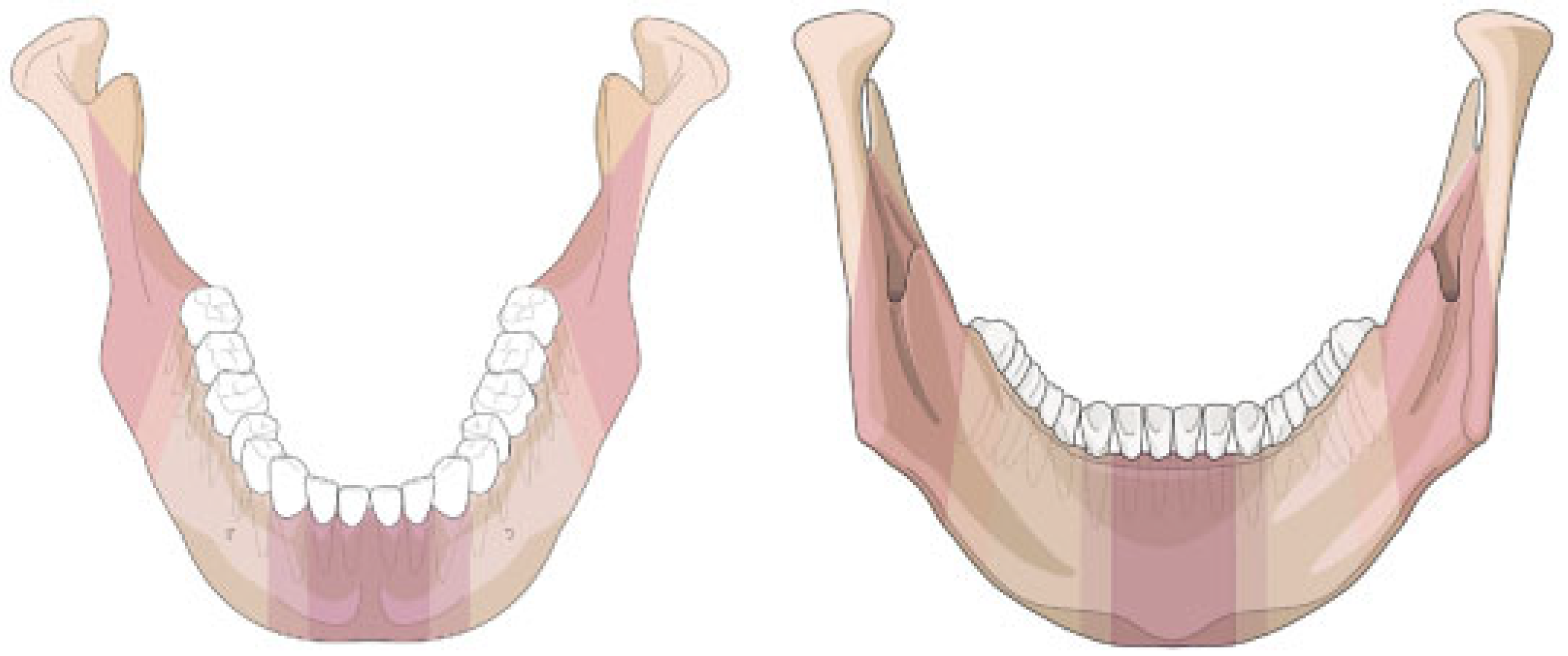
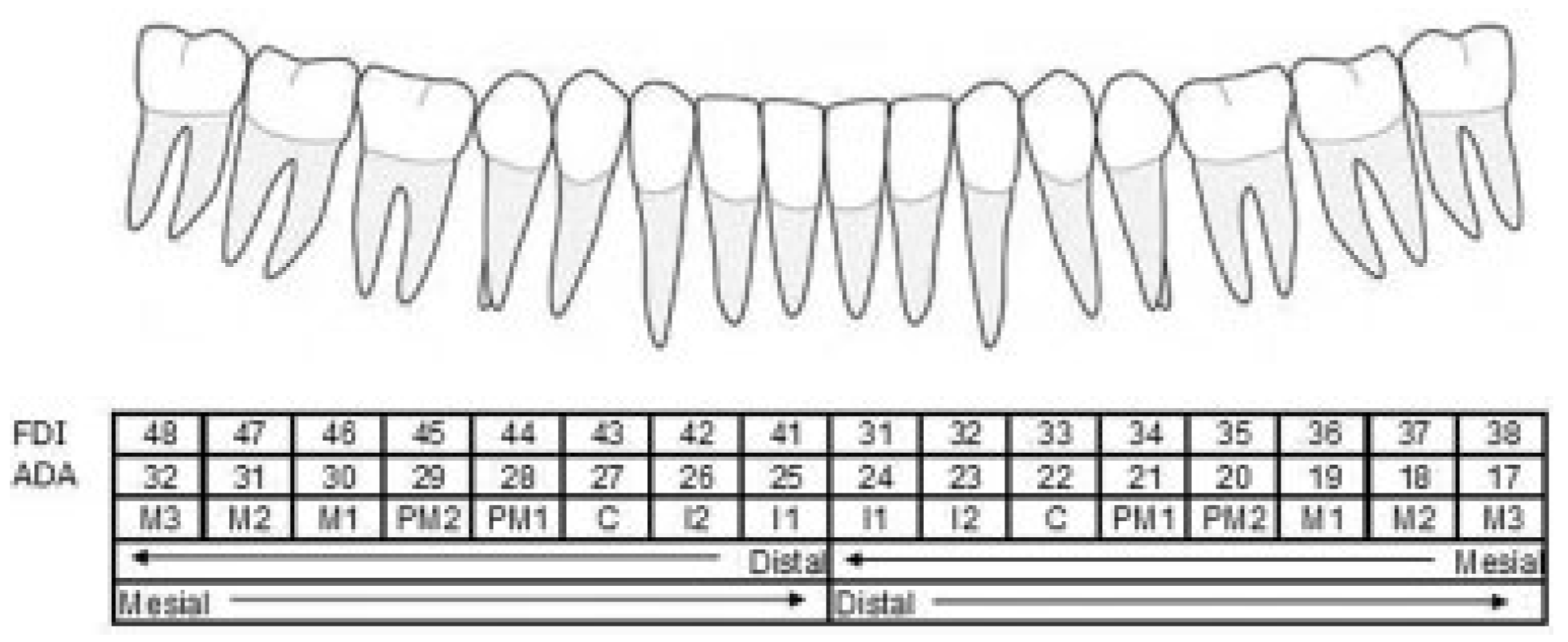
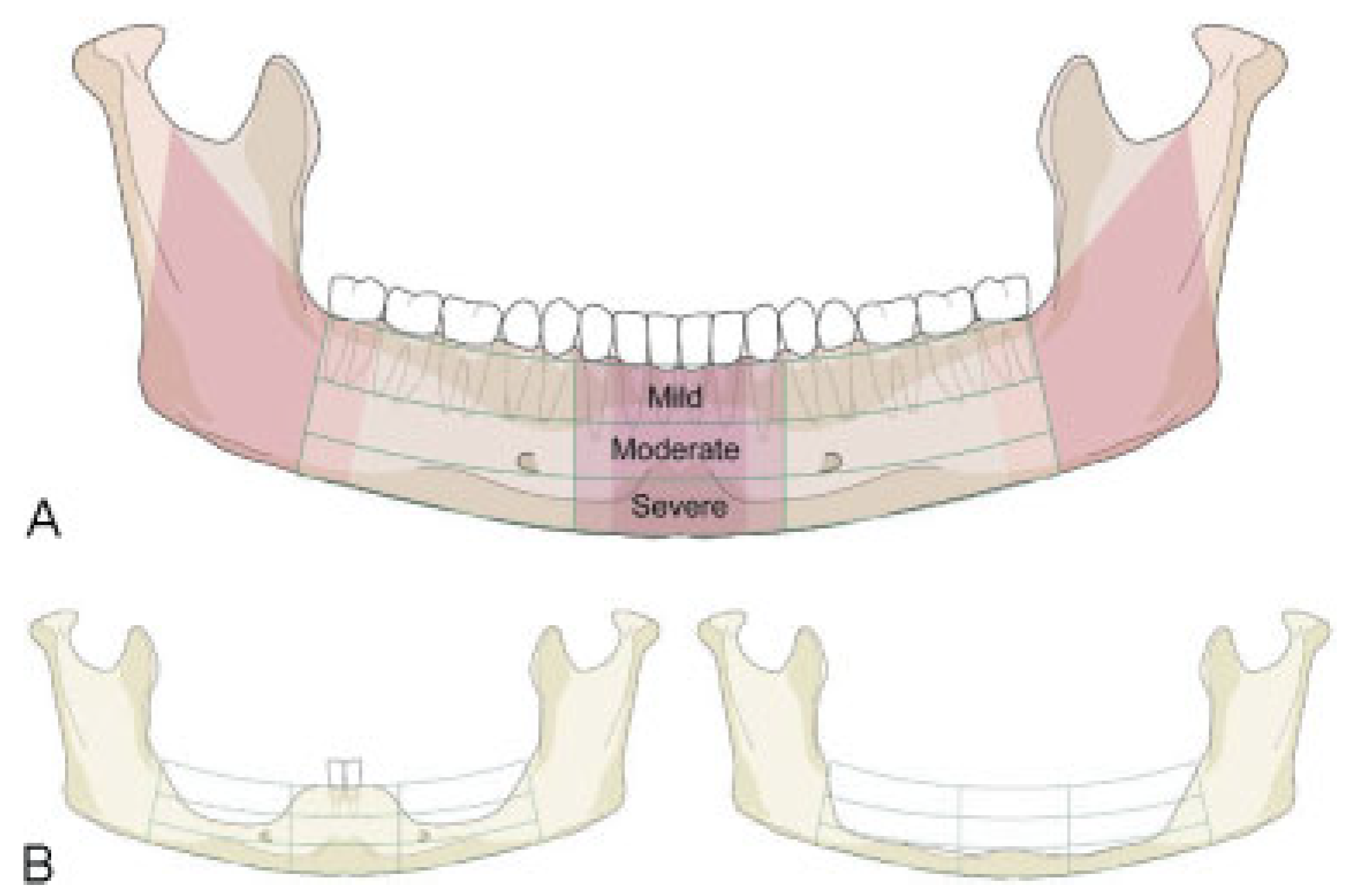
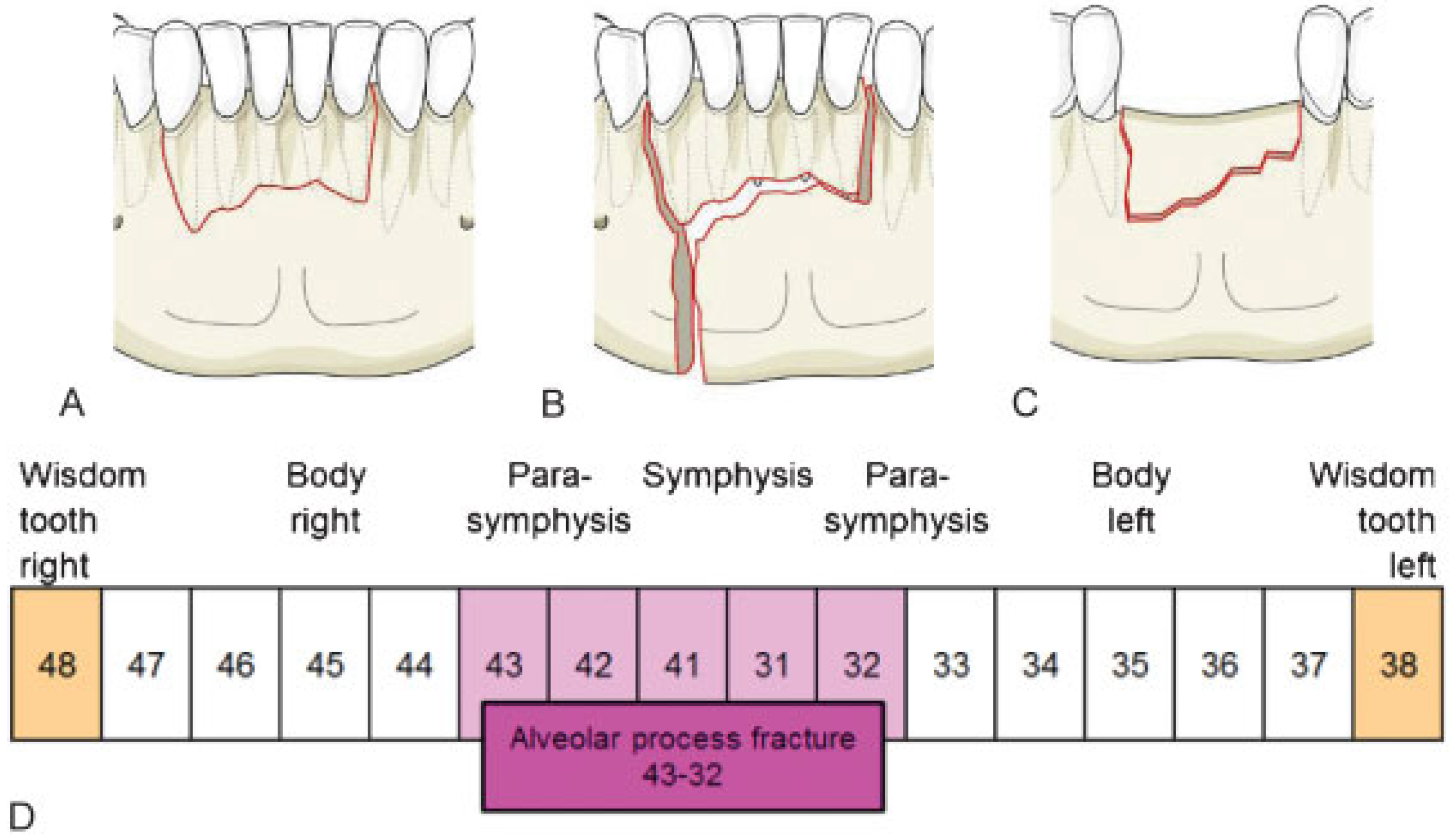
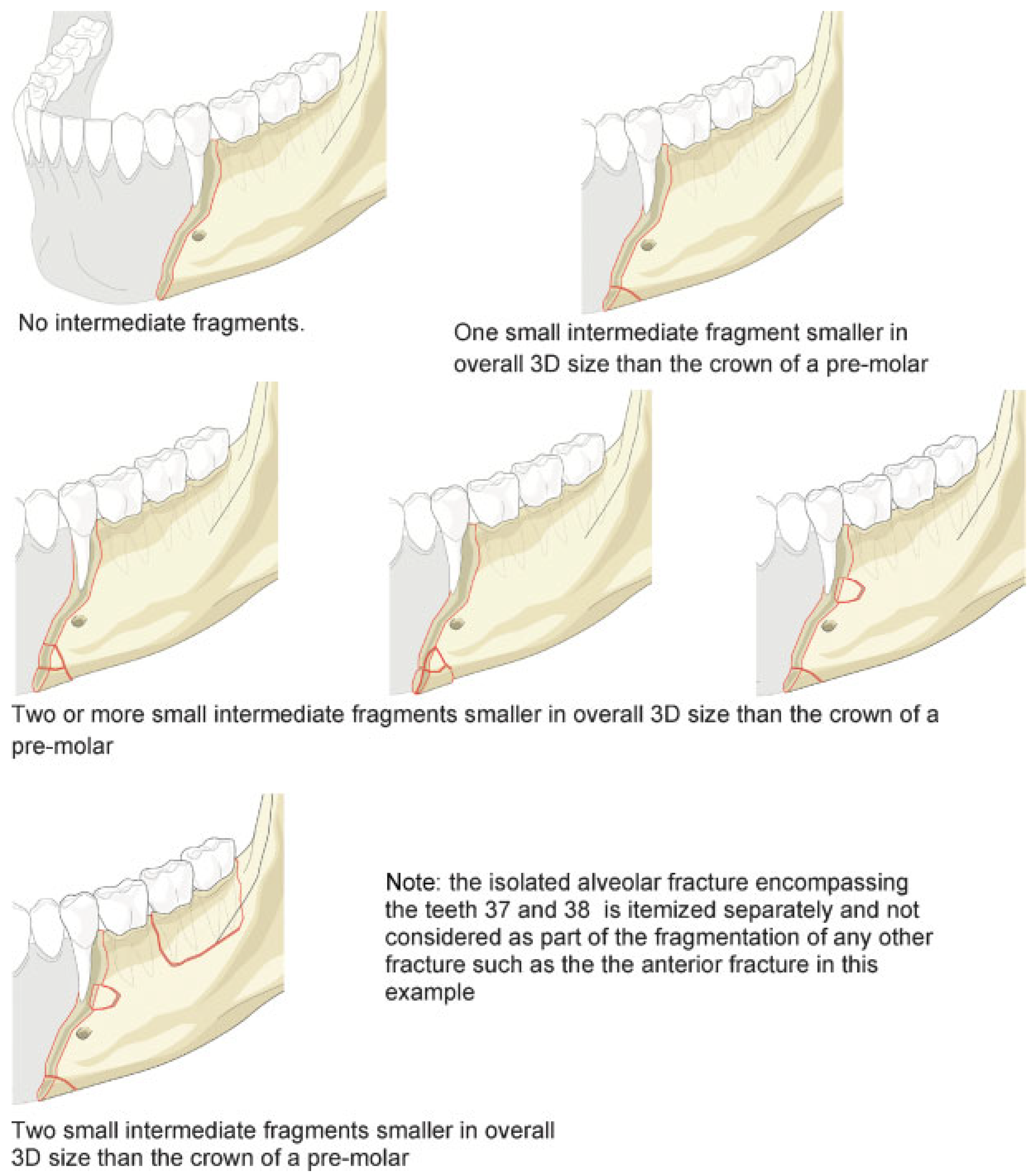






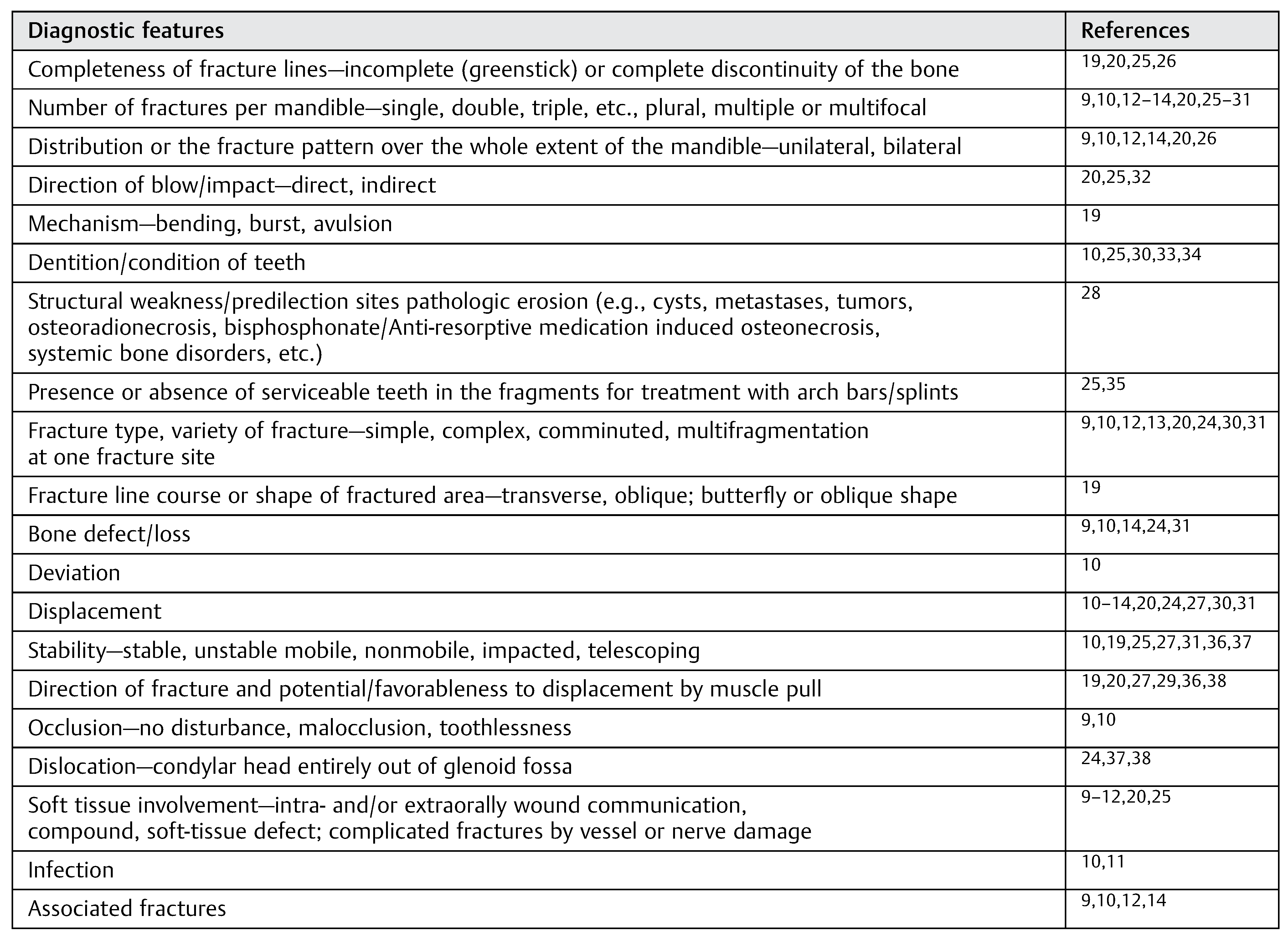
© 2014 by the author. The Author(s) 2014.
Share and Cite
Cornelius, C.-P.; Audigé, L.; Kunz, C.; Rudderman, R.; Buitrago-Téllez, C.H.; Frodel, J.; Prein, J. The Comprehensive AOCMF Classification System: Mandible Fractures-Level 3 Tutorial. Craniomaxillofac. Trauma Reconstr. 2014, 7, 31-43. https://doi.org/10.1055/s-0034-1389558
Cornelius C-P, Audigé L, Kunz C, Rudderman R, Buitrago-Téllez CH, Frodel J, Prein J. The Comprehensive AOCMF Classification System: Mandible Fractures-Level 3 Tutorial. Craniomaxillofacial Trauma & Reconstruction. 2014; 7(s1):31-43. https://doi.org/10.1055/s-0034-1389558
Chicago/Turabian StyleCornelius, Carl-Peter, Laurent Audigé, Christoph Kunz, Randal Rudderman, Carlos H. Buitrago-Téllez, John Frodel, and Joachim Prein. 2014. "The Comprehensive AOCMF Classification System: Mandible Fractures-Level 3 Tutorial" Craniomaxillofacial Trauma & Reconstruction 7, no. s1: 31-43. https://doi.org/10.1055/s-0034-1389558
APA StyleCornelius, C.-P., Audigé, L., Kunz, C., Rudderman, R., Buitrago-Téllez, C. H., Frodel, J., & Prein, J. (2014). The Comprehensive AOCMF Classification System: Mandible Fractures-Level 3 Tutorial. Craniomaxillofacial Trauma & Reconstruction, 7(s1), 31-43. https://doi.org/10.1055/s-0034-1389558



